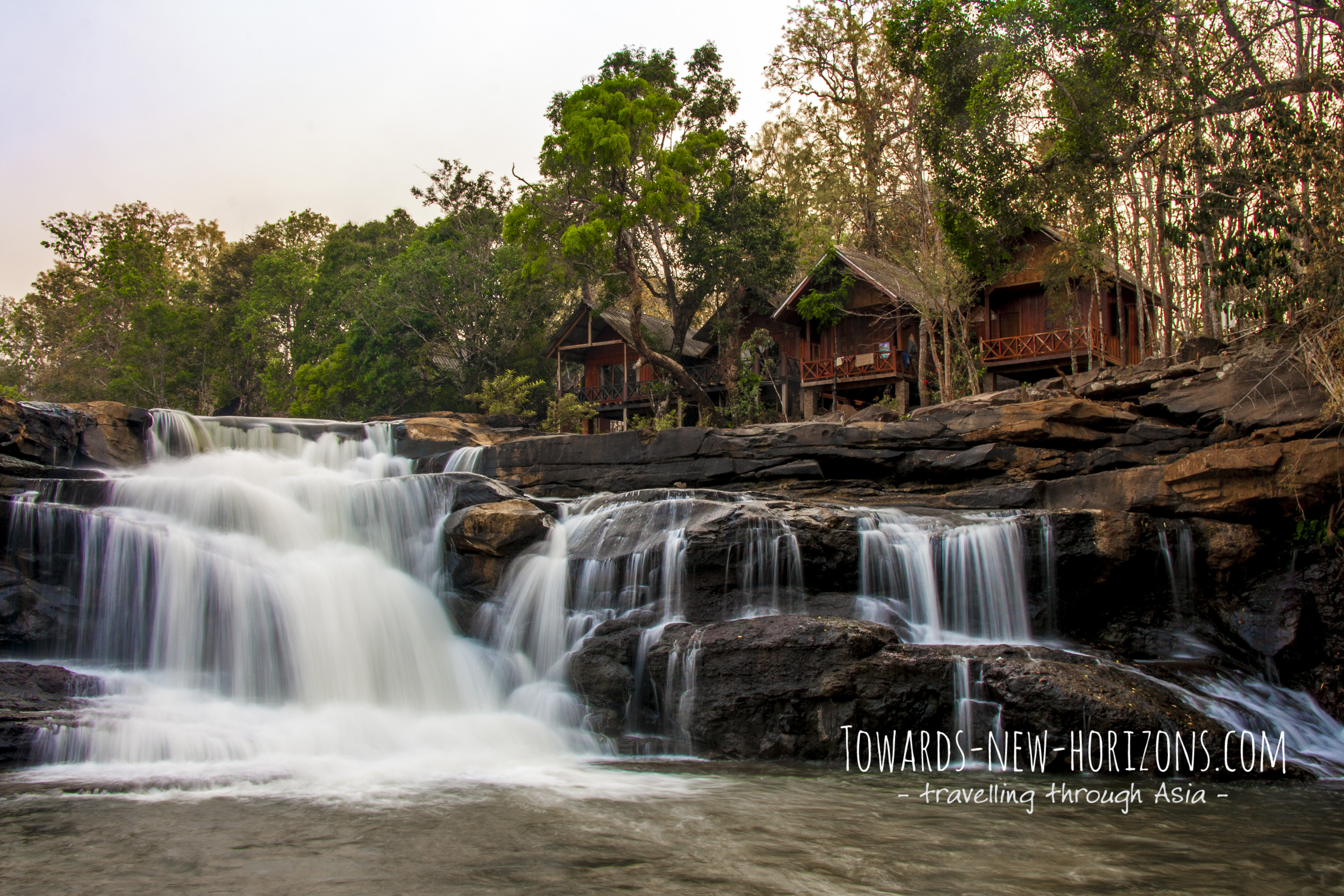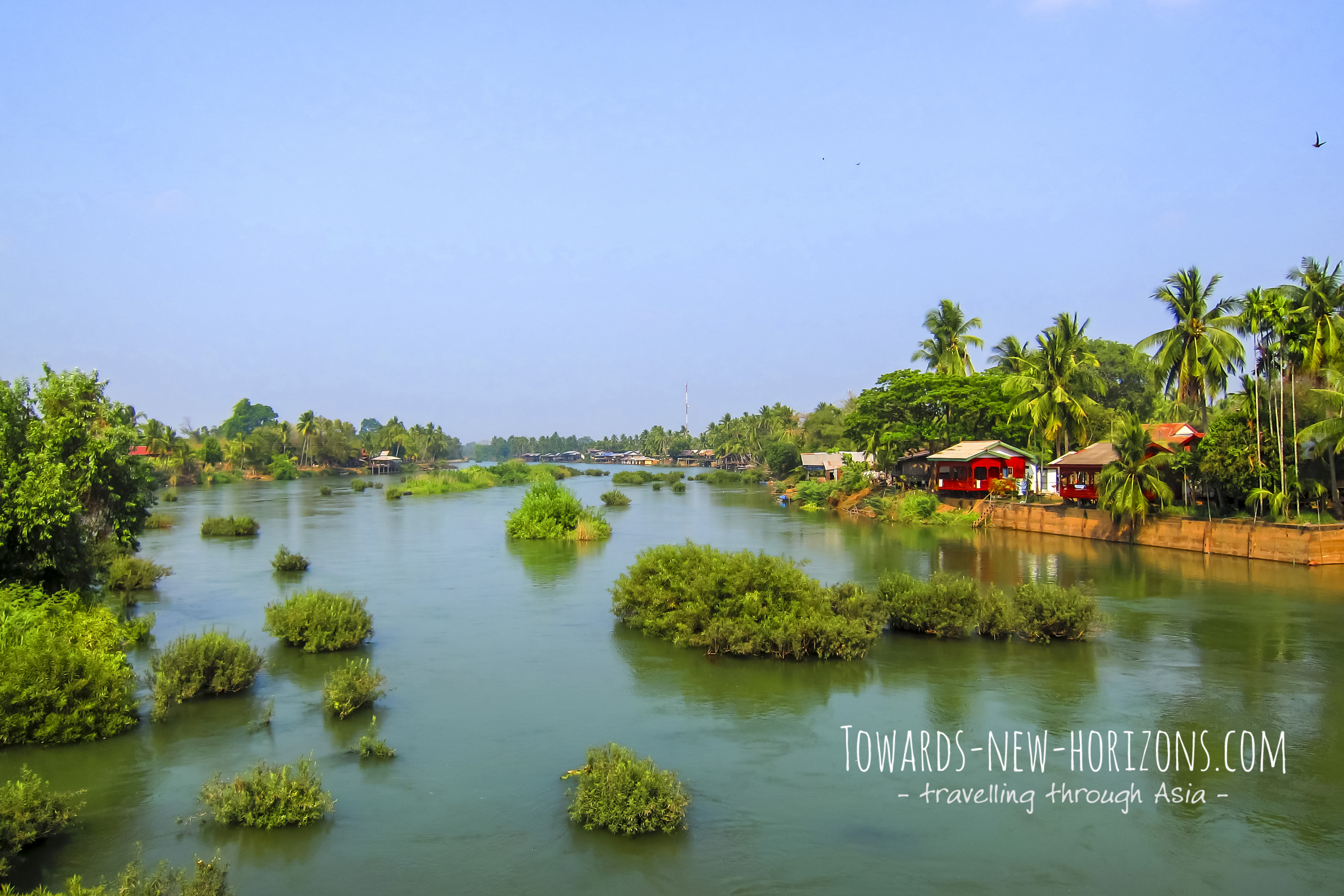Not yet sick of riding our motorbike we drove the next day along the Mekong River to the old Khmer ruins of Wat Phou… (Read more)
Schon am nächsten Tag nach unserer Bolaven Plateau Tour haben wir uns schon wieder auf den Motorroller begeben und sind diesmal nach Süden in Richtung Champassak für einen Tagestrip gecruist… (Weiterlesen)
No cansados aun de viajar en moto, decidimos continuar la ruta motera siguiendo el cauce del rio Mekong hacia el sur y visitar las antiguas ruinas Khmer del templo Wat Phou… (Continuar leyendo)
[fsg_gallery id=”89″]
Wat Phou – Alte Khmer Ruinen & Heiliges Wasser
Not yet sick of riding our motorbike we drove the next day along the Mekong River to the old Khmer ruins of Wat Phou. The ride itself already offered great views and excited children’s eyes, when we stopped for a better look in a remote place where no tourists usually come to.
The remaining ruins of Wat Phou originate from the same period as Angkor Wat in between the 11th and 13th century. But excavation finds show that this site was already used as a temple in the 5th century. The complex, or what’s left of it, thrones at the feet of a hill and a giant stairway climbs its way up the hill. The ravages of time moved the giant stone blocks leaving a rather deformed but not less impressive stairway. Two Palaces and a Library building can be found at the lower part and are currently under restoration. All used stones have very typical small holes carved into them which were needed in that time to pull them up the slope. On the top of the hill, in the shadow of the steep mountain Phu Kao, we were pleased to find the small temple of Wat Phou, which is still used for praying and yet has some mythical flair to it. We were also pleased to run into Tineke and Bastiaan again – it is a small traveler’s world indeed. Further up the Laotian people would fill up their water bottles with holy water that is pressed out of the Mountain rocks. A rock with a deep relief of a crocodile is a rather macabre remnant from pre-Angkor times. The crocodile shape could also fit a human, lying on his back with his arms over his head, and according to a chinese writing from the 6th century, it was used for human sacrifices. I’m glad those days are over 😉
The ruins of Wat Phou definitely got us even more excited about its big; well let’s better call it its giant brother Angkor Wat in Cambodia – which we will shortly see.
All in all an enjoyable day that was made perfect by a simple but delicious vegetarian Indian dinner back in Pakse – getting back some energy for the following travel day.
Wat Phou – Ruinen der Khmer & Heilige Quellen
Schon am nächsten Tag nach unserer Bolaven Plateau Tour haben wir uns schon wieder auf den Motorroller begeben und sind diesmal nach Süden in Richtung Champassak für einen Tagestrip gecruist um die Ruinen von Wat Phou zu besichtigen. Schon auf dem Weg, der entlang des Mekongs führt, bot sich oft ein wunderschöner Ausblick auf die vielen kleinen Inseln.
Wat Phou ist ein Tempelkomplex direkt unterhalb des Berges Phu Kao gelegen dessen verbliebende Strukturen aus dem 11. bis 13. Jahrhundert stammen. Jedoch stand an diesem Ort schon seit dem 5. Jahrhundert ein Tempel, was einige Ausgrabungsstücke zeigen, und diese Stätte ist somit älter als Angkor Wat.
Am Fuße des Berges finden sich der südliche und nördliche Palast und die Reste einer Bibliothek. Eine alte und von der Zeit schon arg deformierte Steintreppe führt auf imposante Art und Weise den Berg hinauf. Alle Steine weisen ein kleines Loch auf, das benötigt wurde um diese massiven Blöcke den Berg hinauf zu transportieren. Wenn man wie die übrigen Pilger die vielen Steinstufen erklommen hat erreicht man Vat Phou, einen Tempel direkt am Fuße des Felsmassives das von da ab steil in den Himmel ragt. Hinter dem Tempel, der wie der Berg Shiva gewidmet ist, ist eine heilige Wasserquelle wo die Pilger sich ihre Wasserflaschen auffüllen.
Dort oben findet man auch einen Elefanten der in einen großen Stein gemeißelt wurde sowie ein Relief eines Krokodils. Dieses diente anscheinend in Vor-Angkor Zeiten als Stätte für jährliche Menschenopfer, wie es in einer chinesischen Schrift aus dem 6. Jahrhundert beschrieben wird. Diese Vertiefung in Form eines Krokodils würde auch gut eine, liegenden Menschen Platz bieten – den Rest kann man sich ausmalen…
Wir haben auf jeden Fall viel Lust bekommen, endlich Angkor Wat als den großen Bruder von Vat Phou zu entdecken. Unsere Pfade nach Süden werden uns zum Glück schon bald dorthin führen, wir sind richtig gespannt.
Wat Phou – Antiguas Ruinas Khmer & Agua Sagrada
No cansados aun de viajar en moto, decidimos continuar la ruta motera siguiendo el cauce del rio Mekong hacia el sur y visitar las antiguas ruinas Khmer del templo Wat Phou cercano a la localidad de Champassak.
El templo de Wat Phou tiene una estructura única. El primer templo fue construido en el siglo V, aunque nada queda ya de esta estructura originaria y los restos que pueden visitarse hoy en día datan de los siglos XI- XIII. Situado a los pies del monte del mismo nombre, el conjunto de elementos se organizan alrededor de un claro eje longitudinal. Siguiendo este mismo esquema de simetría, una escalera situada sobre el eje da acceso al santuario de la parte superior donde un “Linga” (una representación simbólica del dios Shivá) recoge agua sagrada de un manantial de la montaña mediante un canalón labrado.
En la cima de la colina, bajo la protección del monte del monte Phu Kao (antiguamente Lingaparvata), nos encontramos el pequeño templo Wat Phou que aún sigue siendo utilizado como tal y rebosaba de actividad. Siguiendo los pasos de los laosianos nos acercamos a la pared de la montaña donde los más devotos rellenaban botellas de plástico con el agua sagrada que caía goteando de la montaña. Con ese ambiente místico y espiritual propio de los lugares sagrados, el lugar tenía un encanto especial. Y desde luego, era una buena preparación para los Templos de Angkor Wat a donde nos dirigiríamos en un par de días: un aperitivo que nos abría el apetito y nos dejaba con ganas de más…
Buscando las esculturas del cocodrilo y el elefante volvimos a llevarnos una buena sorpresa al encontrarnos de nuevo con Tineke y Bastiaan, ¡el mundo viajero es un pañuelo! También los volveríamos a encontrar el próximo día en el autobús hacia las 4.000 Islas y sería con ellos con quien disfrutaríamos de nuestros últimos días en Laos, pero esta es una historia para otro momento…
volver a la galeria de fotos Flickr
[mappress mapid=”19″ width=”100%” height=”400″ adaptive=”true”]

